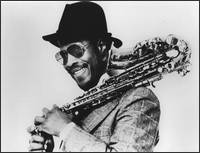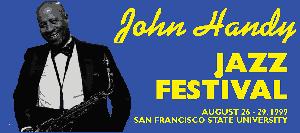John had another taste of stardom with his funk-vocal crossover hit "Hard Work" in 1976. In recent years, the saxophonist has toured and recorded with the Mingus Dynasty and Bebop and Beyond all-star groups, but he kept returning home to work with CLASS. 
The classically trained violinists, Julie Carter, Tarika Lewis, and Sandi Poindexter not only play, but sing, sometimes simultaneously. After having performed around Northern California and at New York's Village Vanguard, John Handy with Class finally went into the studio to record their debut album for Milestone Records. The resulting Centerpiece is, in the best Handy tradition, decidedly different from any other jazz album in recent years. A collection of jazz, blues, and popular standards, in addition to Handy's delightful Louis Jordan-influenced "I Be Itchin' and Scratchin' (To Get You Out of My Life)" original, Centerpiece showcases his molten alto saxophone blended with the warm, sinewy violin tones of Class. Handy, who arranged all the selections, plays alto throughout, except on "Mood Indigo," where he picks up his first instrument, the clarinet, to offer a haunting tribute to the song's composer, Barney Bigard.Yet Centerpiece is much more than an instrumental album. Class and Handy himself vocalize on most cuts and are joined by the resonant baritone of Buddy Conner on two. On "Summertime" and the title tune, CLASS sings and plays at the same time. "Singing is something that I think jazz players had better start doing a lot more of in order to survive and increase our audience," states Handy. "We always did until the Forties, then we all stopped. I'd really like to see more musicians try singing and develop their voices and really do something with it."
"They're a lot prettier than Mike White," Handy says jokingly of his three violinists. "I find the violin to be a very sensitive and expressive instrument capable of musical expressions that other instruments are not. I've discovered that there's a certain way to write for them to give them a saxophone sound."
Handy's association with the violin goes back to the mid-sixties when he led a high-energy group that featured violinist Michael White. Later, the saxophonist played with Indian violin virtuoso L. Subramaniam in an all-star multi-cultural band called Rainbow, which Handy and Ali Akbar Khan created in 1971. During a concert tour in 1981 he invited three musicians of the Music Ensemble of Benares to play with Rainbow: Pandit Prakash Maharaj (tabla), Shivanath Mishra (sitar) and Gunther Paust (tanpura). These musicians later came to form John Handy's Musical Dreamland, which has continued to tour, mainly in Europe and Japan for the past several years.
In addition to these groups, he has also become reacquainted with the legendary John Handy Quintet over the past two years, who had cut two albums in 1965-66. Making their debut at Yoshi's in Oakland in 1994, they have continued to perform throughout California.
In fact, as a tribute to the group and in response to extraordinary pressure from his fans, Koch Jazz has recently reorganized, digitally remastered, reproduced, and re-released John Handy's Live at the Monterey Jazz Festival recording from 1965.
John Handy Recordings
|
In the Vernacular 1959, Roulette Records
No Coast Jazz
Jazz
Live at Monterey
John Handy
Second John Handy Album
Quote Unquote
New View
Projections
Karuna Supreme
Hard Work
Carnival
Where Go the Boats
Excursion in Blue
Centerpiece ; with Class
Very First Recordings
Live at the Monterey Jazz Festival
Live at Yoshi's
Musical Dreamland
Handy Dandy Man
|
|
1959, Mingus, Charles,
1959, Mingus, Charles,
1959, Mingus, Charles,
1964, Mingus, Charles,
1964, Mingus, Charles,
1965, Great Moments in Jazz,
1971, Mingus, Charles,
1974, Mingus, Charles,
1979, Mingus, Charles,
1980, Mingus Dynasty,
1981, Subramaniam, L.,
1981, Stitt, Sonny,
1988, Mingus, Charles,
1990, Mingus, Charles,
1994, Mingus, Charles,
1996, Mingus, Charles,
|

